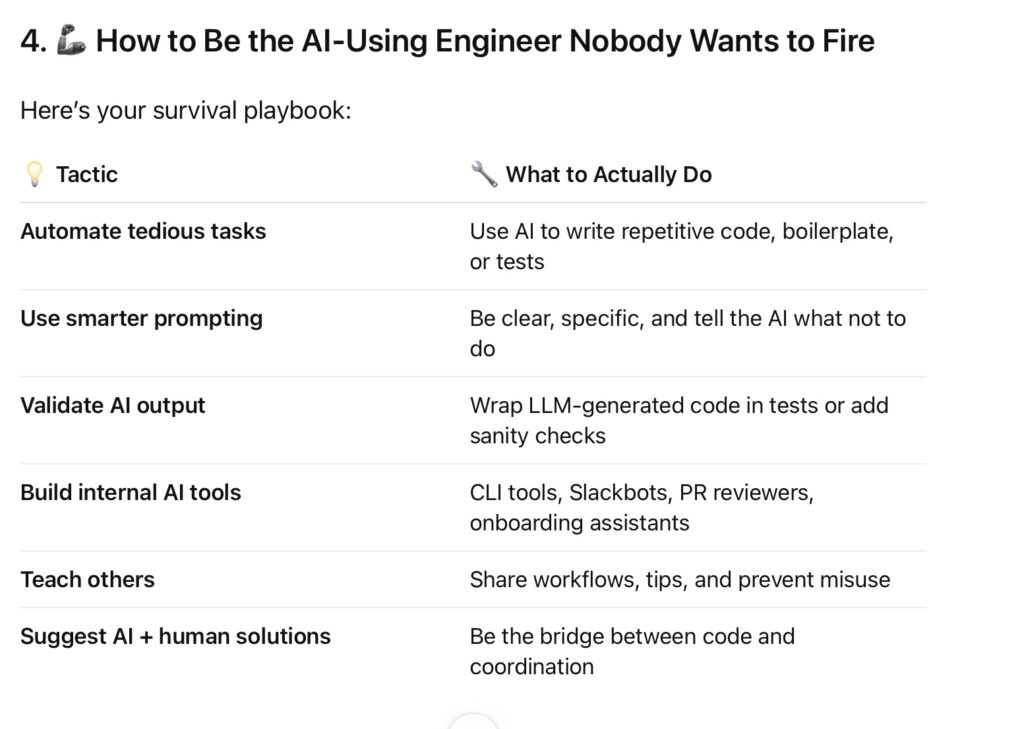
ChatGPT:
🛠️
The Developer Survival Handbook: AI Edition
“Don’t Just Learn AI — Learn to Wield It Better Than the People Trying to Replace You.”
A field guide for software engineers in the age of robots, restructuring, and resume rewrites.
📖 Table of Contents
- Welcome to the Post-Human Coding Era
- Why “Learning AI” Isn’t Enough
- The Three Kinds of Developers (and Who Gets Replaced)
- How to Be the AI-Using Engineer Nobody Wants to Fire
- Tools, Tactics & Prompts
- The Developer’s Prayer to the Debugging Gods
- Final Notes from the Future
1. 💼 Welcome to the Post-Human Coding Era
Congratulations. You’re a software engineer in the most unstable version of the tech industry since the Great Jira Rebellion of 2018.
- LLMs are writing code
- Execs are laying people off by the hundreds
- And HR is holding “AI Enablement” meetings while quietly updating the severance letter template
Here’s the truth:
LLMs aren’t replacing you. But the people using LLMs better than you? They might.
2. 🤖 Why “Learning AI” Isn’t Enough
You’ve heard the advice:
“You should learn AI to stay relevant.”
But here’s what they don’t say:
- Everyone is learning AI now
- Most people don’t know how to actually use it effectively
- Simply knowing what “transformers” are won’t save your job
The real move?
Become the person who uses AI better than the people trying to automate you.
3. 🧠 The Three Kinds of Developers (and Who Gets Replaced)
🥱 The Passive Learner
- Watches AI videos
- Adds “AI-curious” to LinkedIn
- Still waits 45 minutes for npm install
- 🚫 Most likely to be automated
🛠️ The AI Tinkerer
- Uses LLMs to generate tests, docstrings, or bash scripts
- Writes custom prompts for recurring problems
- Builds little helpers in the corner of the codebase
- ✅ Keeps their job and doubles productivity
🧙♂️ The Workflow Sorcerer
- Reorganizes workflows to be AI-first
- Builds internal tooling with LLM APIs
- Speaks prompt as a second language
- 👑 Gets promoted or irreplaceable (or both)

5. 🛠️ Tools, Tactics & Prompts to Keep in Your Pocket
🧷 Good Prompts for Code:
- “Write a Python function to X, and include input validation.”
- “Refactor this code to follow best practices in Django.”
- “Explain this code like I’m a junior dev.”
- “Generate tests for this function. Include edge cases.”
🧯 For Preventing Hallucinations:
- “If unsure, say ‘I don’t know.’ Do not guess.”
- “Only use real libraries, do not invent imports.”
- “Give links to docs if you cite tools.”
🧰 Tools to Get Comfortable With:
- GitHub Copilot
- GPT-4 for system design whiteboarding
- Claude for documentation and rubber ducking
- Local LLMs for sensitive/internal data
- Retrieval-Augmented Generation (RAG) setups for team knowledge
6. 🙏 The Developer’s Prayer to the Debugging Gods
Whisper this before every deployment.
Oh mighty Debugging Gods,
Whose stack traces descend like cryptic haikus,
Whose logic tests the faithful and humbles the proud,
I come before thee with trembling fingers and 12 open tabs.
Bless this code I summoned from ChatGPT. Though it runs, let it run correctly.
Deliver me from null, lead me not into NaN,
And forgive me for trusting that auto-generated test.
May the compiler show mercy,
May the git blame show not my name,
And may prod never know what I did in staging.
In the name of Turing, Python, and clean commits,
Amen.
7. 🧭 Final Notes from the Future
LLMs are not the end of programming.
They’re the beginning of a new skill stack.
You won’t survive by being a better typist.
You’ll survive — and thrive — by being:
- A better problem solver
- A faster integrator
- A cleverer AI prompt writer
- A deeply human mind working with a very powerful, very dumb machine
The good news?
If you’re reading this, you’re already ahead of the curve.
Now copy this handbook into your doc editor of choice, export it to PDF, print it out, and tape it to the inside of your laptop lid.
Then go forth and outsmart the bot.

